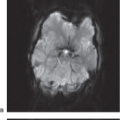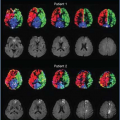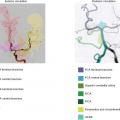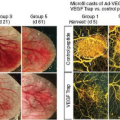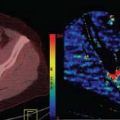Primer on CT Physics and Hardware
Jiang Hsieh
Marc Kachelriess
Overview of CT History
Since the introduction of the first clinical computed tomography (CT) scanner by EMI, x-ray CT has undergone four decades of exciting research and development, going from acquiring one slice of images in several minutes to completely covering the entire human body in a few seconds. The type of scanner built by EMI in 1971 is commonly called first-generation CT with the characteristics that only one pencil beam is measured at a time. The x-ray source was collimated to a narrow beam of 3 mm wide and 13 mm long, and the x-ray source and detector were linearly translated to acquire individual measurement. After the completion of the linear measurements, both the x-ray tube and the detector rotated 1 degree to the next angular position to acquire the next set of measurements, as shown in Figure 1.1A.
To overcome the serious issue of patient motion during the 4½ minutes of data acquisition,1 the second-generation CT scanner was introduced, where the number of rotation steps is reduced by the use of multiple pencil beams. When six detector cells are used instead of one, each projection measures six different angles, which allows the x-ray tube and detector to rotate 6 degrees at a time during the data acquisition, representing a factor of six reductions in the acquisition time (Fig. 1.1B). In late 1975, EMI introduced a 30-detector scanner capable of acquiring a complete scan in under 20 seconds.2
The introduction of the third-generation CT scanner completely eliminated the translation motion of the data acquisition. In this configuration, a large number of detector cells are located on an arc concentric to the x-ray source so that the entire object is within the detector field of view at all times (Fig. 1.1C). The x-ray source and the detector remain stationary relative to each other while the entire apparatus rotates about the patient. This type of scanner was and remains the most widely used scanner design.
Technical challenges in the design of the third-generation CT, such as detector stability and aliasing artifacts, led to the investigation of the fourth-generation CT concept, as depicted in Figure 1.1D. In this design, the detector forms an enclosed ring and remains stationary during the entire scan while the x-ray tube rotates about the patient. One of the advantages of the fourth-generation scanner is that the spacing between adjacent samples in a projection is determined solely by the rate at which the measurements are taken and higher sampling density can eliminate potential aliasing artifacts. In addition, because each detector cell is exposed directly to the x-ray source at some point during each rotation, the detector can be recalibrated dynamically during the scan. Because each detector cell has to receive x-ray photons over a wide angle, however, no effective and practical scatter rejection can be performed by postpatient collimator. A more difficult drawback to overcome is the number of detectors required to form the complete ring and that the cost of the detectors would be prohibitive for multislice scanner configurations. This led to the disappearance of such scanners from the market.2
Electron-beam CT, sometimes called the fifth-generation CT scanner, EBCT, or EBT, was built between 1980 and 1984 for cardiac applications.3 In such scanners, the source rotation is provided by the sweeping motion of the electron beam (instead of the mechanical motion of the x-ray tube) as shown in Figure 1.2. A high-speed electron beam is focused and deflected by carefully
designed coils to sweep along the target ring, similar to a cathode ray tube, with the entire assembly sealed in vacuum. Because there is no mechanical moving part in the system, scan times as fast as 33 msec can be achieved.
designed coils to sweep along the target ring, similar to a cathode ray tube, with the entire assembly sealed in vacuum. Because there is no mechanical moving part in the system, scan times as fast as 33 msec can be achieved.
 FIGURE 1.1. Different generations of CT scanners: (A) First generation, (B) second generation, (C) third generation, and (D) fourth generation. |
In early vintage third- or fourth-generation scanners, both the x-ray tube power and the detector signals were transmitted by cables, and the limitations on the cable length forced the gantry to rotate both clockwise and counterclockwise to acquire adjacent slices. The acceleration and deceleration of the gantry restrict the scan speed to roughly 2 seconds per rotation with additional interscan delay to account for the acceleration and deceleration periods. Later models use slip-rings for power and data transmission and this technology was a key to the success of helical or spiral CT. In the helical mode, the data acquisition is continuous throughout the entire scan while the patient table is translated at a constant speed (Fig. 1.3). This is in direct contrast to the conventional step-and-shoot mode in which the data acquisition stops after each gantry rotation and waits for the patient table to move to the next location. During the data acquisition time, the patient remains stationary.4,5 The advantages of the helical mode are the elimination of the interscan delay, which enables a nearly 100% duty cycle, and the uniform sampling along the patient’s long axis (z-axis). The latter improves small lesion detection and the reformatted or rendered image quality by providing overlapped reconstruction. Helical scanners enable the coverage of an entire human organ in a single breath-hold in clinical settings.
 FIGURE 1.2. Fifth-generation CT scanner. The electron beam sweeps across the target by the controlling magnetic fields and mechanical moving components are avoided for data collection. |
One of the most recent advances is the multislice CT scanner. Prior to its introduction, one often faced the tradeoff between coverage and spatial resolution along the patient’s long axis (z-axis), because the detector had no spatial discrimination capability in z and the slice thickness of the scanner is determined primarily by the width of the collimated x-ray beam. In multislice CT, the original single-slice detector cell is subdivided along the z-axis into several cells to provide z-resolution capability. Here, the width of the collimated x-ray beam can be independent of the spatial resolution or the slice thickness.6,7,8,9,10 For example, on a 64-slice CT system,
64 detector cells each with a width (in z) of 0.625 mm can collectively cover a range of 40 mm (64 × 0.625). Such a system can produce an image slice thickness of 0.625 mm, and the entire collimated x-ray beam width (in z) is 40 mm. The advantage of the multislice CT system is its ability to provide isotropic spatial resolution in routine clinical applications. Isotropic spatial resolution is one of the key parameters on the image quality of reformatted or volume-rendered images. For illustration, Figure 1.4 shows a schematic diagram of a four-slice scanner and an example of a volume-rendered clinical image.
64 detector cells each with a width (in z) of 0.625 mm can collectively cover a range of 40 mm (64 × 0.625). Such a system can produce an image slice thickness of 0.625 mm, and the entire collimated x-ray beam width (in z) is 40 mm. The advantage of the multislice CT system is its ability to provide isotropic spatial resolution in routine clinical applications. Isotropic spatial resolution is one of the key parameters on the image quality of reformatted or volume-rendered images. For illustration, Figure 1.4 shows a schematic diagram of a four-slice scanner and an example of a volume-rendered clinical image.
CT Physics
In the following two sections first the generation of x-rays and thereafter their interaction with matter are discussed.
X-Ray Generation
Similar to microwaves, infrared, visible light, ultraviolet, and radio waves, x-ray is an electromagnetic waveform with wavelengths ranging from a few picometers to a few nanometers. Although x-ray photons used in CT are produced by bombarding a material with high-speed electrons, most of the encounters do not produce x-rays. Over 99% of the input energy is converted into heat. It is clear that this is an inefficient x-ray production process and the heat management is one of the key issues in the x-ray tube design.
There are three types of interactions that do lead to the production of x-rays: (a) The first type of interaction occurs when the electron approaches close to the nucleus of the atom and the high-speed electron travels partially around the nucleus owing to the attraction between the positive nucleus and the negative electron. The sudden deceleration of the electron gives rise to the so-called bremsstrahlung radiation and the energy of the resulting radiation depends on the amount of incident kinetic energy that is given off during the interaction. This type of radiation is responsible for the white radiation, which covers the entire energy range of the spectrum. (b) The second type of interaction occurs when the high-speed electron
collides with one of the inner shell electrons of the target atom and liberates the inner shell electron. When the hole is filled by an electron from an outer shell, characteristic radiation is emitted with its energy being the difference between the binding energies of two shells. (c) The third type of interaction occurs when an electron collides directly with a nucleus and its entire energy converts to x-ray radiation. The x-ray energy produced by this interaction represents the upper energy limit in the x-ray spectrum. Figure 1.5 shows the x-ray production process and a typical x-ray spectrum produced on an x-ray tube.
collides with one of the inner shell electrons of the target atom and liberates the inner shell electron. When the hole is filled by an electron from an outer shell, characteristic radiation is emitted with its energy being the difference between the binding energies of two shells. (c) The third type of interaction occurs when an electron collides directly with a nucleus and its entire energy converts to x-ray radiation. The x-ray energy produced by this interaction represents the upper energy limit in the x-ray spectrum. Figure 1.5 shows the x-ray production process and a typical x-ray spectrum produced on an x-ray tube.
X-Ray Interaction with Matter
The intensity of an x-ray beam is reduced as it passes through a material, indicating that the x-ray beam is attenuated by a material on its path. The amount of attenuation depends on the incident x-ray photon energy, the property of the material, and the amount of material the x-ray has to penetrate, and this relationship is described by the Beer’s law:
where Io and I are the incident and transmitted x-ray intensities, μ is the energy-dependent linear attenuation coefficient of the material, and L is the thickness of the material. As depicted in Figure 1.5, the typical energy range of the x-ray photons generated for medical CT is roughly between 20 keV and 140 keV (x-rays with energy below 20 keV are typically filtered out by the x-ray tube window and other materials). In this energy range, there are three fundamental ways in which x-rays interact with matter: The photoelectric effect, Compton, and coherent scattering.
The photoelectric effect occurs when the incident x-ray photon energy is greater than the binding energy of an electron in the material, and the photon gives up its entire energy (therefore ceasing to exist) in liberating an electron, called a photoelectron, from a deep shell of an atom. The hole created at the deep shell is filled by an outer shell electron and a characteristic radiation results (Fig. 1.6A). Thus, a photoelectric effect produces:
a positive ion;
a photoelectron; and
a photon of characteristic radiation.
This effect was first explained by Albert Einstein in 1905 for which he received the Nobel Prize in Physics in 1921.
The second type of interaction, the most important interaction mechanism in tissue-like materials, is the Compton effect, named after Arthur Holly Compton who received the Nobel Prize in 1927 for its discovery. In this interaction, the energy of the incident x-ray photon is considerably higher than the binding energy of the electron and frees the electron from the atom. The incident x-ray photon is deflected or scattered with partial loss of its initial energy (Fig. 1.6B). Thus, a Compton interaction produces:
a positive ion;
a “recoil” electron; and
a scattered photon.
The scattered photon may be deflected at any angle from 0 to 180 degrees. Because of the wide deflection
angle, the scattered photon provides little information about the location of the interaction and the photon path, and many efforts have been made to reduce its negative impact on noise, low contrast detectability, and artifacts.
angle, the scattered photon provides little information about the location of the interaction and the photon path, and many efforts have been made to reduce its negative impact on noise, low contrast detectability, and artifacts.
For typical clinical applications, the third type of interaction, coherent scattering, is less important and the interaction mechanism will not be discussed here. The x-ray attenuation is observed in the CT measurement results from the combined effects of the photoelectric, Compton, and coherent scattering. For illustration, Figure 1.7 shows the attenuation coefficients for three commonly encountered materials in CT: Iodine, bone, and soft tissue.
Stay updated, free articles. Join our Telegram channel

Full access? Get Clinical Tree







